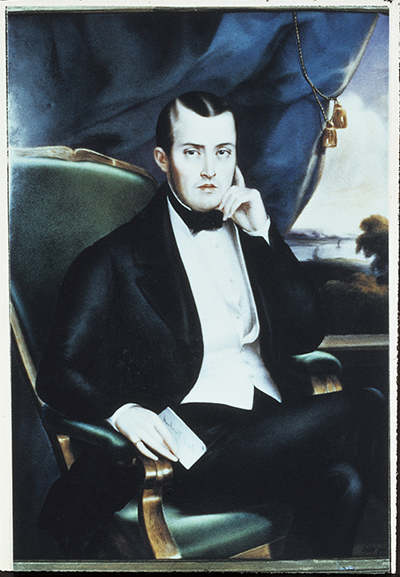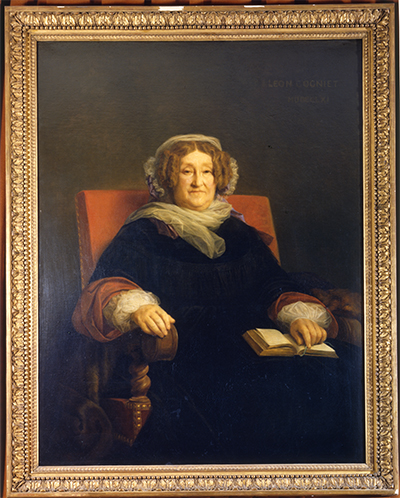French entrepreneur families
Some of the most famous brands in France were initially and often still are family businesses. A few even headed by women! Meet six historic French entrepreneur families starting with Chaumet the creator of the 2024 Paris Olympics Medals.
Chaumet
Marie-Etienne Nitot was an 18th century creator. He started near the top apprenticing to Marie-Antoinette’s personal jeweller. In 1780 he founded his own maison. He survived the trauma of the Revolution to thrive under Napoleon who had an ambition to re-make France a center for luxury and fashion. Beginning with Napoleon’s coronation sword Nitot became an important creator for the Empire and one of the most sought after jewellers in Europe. His son took the reins in 1812 and set up on Place Vendome. Joseph Chaumet became the director in 1885. His signature in the time of the belle epoque was nature-inspired aigrettes and tiaras which were social symbols. Tiaras morphed into graphic headbands in the roaring twenties as materials like platinium made jewelry lighter-weight. Ever searching for the avant garde Chaumet has adapted to styles and trends as well as new techniques throughout the centuries. Now part of LVMH, the Maison is still a symbol of French elegance and savoir-faire honored with the design of the 2024 Paris Olympic Medals. The roughly 5000 Olympic and Paralympic medals will be minted by the Monnaie de Paris. #chaumet #olympicmedals Read about the symbolism of the Paris Olympic Medals.
The Haviland family: Haviland Porcelain
This family is a real franco-american immigration tale! A Norman family since the time of the English invasion, they left France for the US in 1648 to join the Quaker colony in Providence, RI, then generations later a certain David returned to France to start producing and exporting porcelain. David’s son, Theodore, whose name was backstamped in on the early Haviland porcelain, was born in France in 1842. David was 100% American by several generations and knew no French, nor how to make porcelain. First he exported some porcelain pieces he purchased in France to his brother’s shops in NYC. It sold well, so he began actual production in styles that were more adapted to American tastes. Then the US Civil War ruined them. At the end of the war Theodore was sent to the US to rekindle the business and they once again had huge success. The Havilands developed chromolithography, a method of transferring a design to the porcelain as opposed to hand painting, and modernized their designs by hiring artists. Theodore then when back to the Limoges area of France to start his own factory where Haviland porcelain is still produced today. The Haviland family was also known for their Quaker principles. They created emergency funds, vacation and housing options for their employees during the 19th century well before this became standard practice or was legislated. https://www.haviland.fr/en/ #Havilandlimoges
The Cadolle family, makers of fine and haute couture lingerie
One of the French entrepreneur families headed by a woman is Cadolle. Herminie Cadolle was a militant, had she lived in the 21st century she might have been a suffragette or worn a pussy hat. She grew up in the Yonne Department which is not too far east of Paris, married near Blois then moved to Paris with her husband and young son. By trade she was a corset maker and her husband a painter and so they were easily able to find jobs in Paris. They participated in the Commune in 1870 and were arrested, then graced. After several more years of political agitation, Herminie, now a widow, left Paris for Buenos Aires where she opened a lingerie shop. Then, ever the feminist and activist, she had a great idea to liberate women. To make women more comfortable she created a two piece corset. Essentially she invented the bra, which vis à vis to a corset was liberating. When she returned definitively to Paris in 1910 she opened a shop on Chaussée d’Antin and the Maison Cadolle was founded. As time went on the family business was run by Marie, Marguerite, Alice and now the 6th generation of Cadolles, Poupie Cadolle, who is a direct descendent of Herminie. As Poupie says « Cadolle est une entreprise familiale de savoir-faire, de luxe et de tradition. C’est une vraie saga de femmes. Nous sommes vouées aux femmes et nous avons le culte du corps, de la séduction et du raffinement « . [Cadolle is a family company of savoir-faire, luxury and tradition. A true tale of women. We are dedicated to women and we respect their bodies, seduction and refinement.] Today they have online sales, a shop in Paris at 4 rue Cambon and a haute couture custom lingerie salon at255 rue Saint Honoré. The House has created lingerie for Mata Hari, Coco Chanel, the Duchesse of Windsor and other glamorous ladies. All their products are made in France. www.cadolle.fr #cadolle
The Cliquot Family: Champagne Veuve Cliquot Ponsardin
Beginning in 1772, Philippe Clicquot, from a family of bankers and textile merchants, had a vineyard. He wanted to expand internationally and shipped his first champagne to Venice. When his son died in 1805 the son’s widow Barbe Clicquot Ponsardin, decided to take charge of the family business – a rather daring idea for the time period. Madame Clicquot was born in Reims in 1777, she was the daughter of baron Nicolas Ponsardin and received a traditional education strong in moral values typical of the time period. It is said that two words summed up her personality: audacity and intelligence. Shortly after taking over Madame Clicquot, she made her first innovation by producing the first dated (millésime) bottles of Champagne. In 1814 under the Napoleonic Empire she ignored the continental blockade and shipped more than 10,000 bottles of her product to Russia. The champagne was a triomphe in Russia and was celebrated by Pouchkin, Tchekov and Gogol. On the technical side Madame developed the riddling table which allows the sediment in the bottles to collect in the neck, making removal easy. She was also the first to add red wine (instead of berries) to make a pink champagne. 1877 she had another bright idea and made the vineyard’s label yellow. This distinctive label became one of the principle marks of recognition of the brand. Throughout her tenure at the helm she continued to better the wine’s qualities with new techniques and expanded production. Her homologues called her « la grande dame de la Champagne ». After many generations of being family run Veuve Clicquot is now part of another French entrepreneur family: LVMH. #veuveclicquot
The Vuitton Family: Trunk makers & Leather goods
It was in 1837 that a 16-year-old Louis Vuitton arrived in Paris on foot and started apprenticing for Monsieur Maréchal. He was already skilled with tools having grown up in the Jura region with a miller and carpenter for a father already French entrepreneur families. At the time, horse-drawn carriages, boats and trains were the main modes of transportation and baggage was handled roughly. Travelers called upon craftsmen to pack and protect their luggage. Louis Vuitton quickly became a valued craftsman making trunks under Monsieur Maréchal where he worked for 17 years before opening his own workshop and brand at 4 Rue Neuve-des-Capucines near the Place Vendome.
The development of travel thanks to the steam engine meant Louis Vuitton had to expand his operations. This lead to the 1859 opening of his atelier in Asnières just northeast of Paris. There were 20 employees, by 1900, there were nearly 100 people and by 1914 there were 225.
The Asnières atelier has been expanded throughout the decades, including the addition of the Vuitton family residence, and products are crafted there today. While the family home has been preserved and is part of a private museum, 170 craftsmen still work in the Asnières workshop, designing and creating leather goods and special orders for clients around the world.
One of the most important innovations that came out of the atelier in 1886 was an unpenetrable lock, called the tumbler lock, with two spring buckles to protect the trunks. After several years of development, George Vuitton patented this revolutionary system and it was so effective, he challenged in a public newspaper Harry Houdini, the great American escape artist, to escape from a Vuitton box and lock. Houdini didn’t take up the challenge, but the lock’s effectiveness is indisputable. It is still used today. It was also George who created the famous Monogramme LV cloth. Like with the Maison Veuve Clicquot the family remained the principal shareholders until 1989 then became part of LVMH. #LouisVuitton
The Boulgione Family: Cirque Bouglione
Another of the French entrepreneur families are circassians. The Cirque d’Hiver in Paris was constructed and inaugurated under the second Empire in 1952 and was originally called the Cirque Napoléon. A few years later, in 1859, the circus presented the first ever ‘flying trapeze’, an act invented by Jules Léotard, who’s name is also known as the eponym of the leotard. The Bouglione family epic as one of the foremost circus families of France began in the 19th century, with love at first sight between a young gypsy lion tamer and the son of an Italian draper. A few years later, Scipion Boglioni ‘Frenchified’ his name to Bouglione and moved to France, where they showcased fairground menageries. The Bouglione family has been running and performing at the Cirque d’Hiver in the center of Paris since 1907 and became owners in 1934. Rosa and Joseph Bouglione were married in the lion cage with the priest standing prudently outside in 1928. Their grandchildren continue to run the circus today. In 1926 their show, strongly inspired by the American epic and called Captain Buffalo Bill’s Stage Show, made their fame. It was a great success! During WWII their Italian sounding name permitted them to operate under the Nazis. The 1950s to the 1990s shows were marked by a wide variety of international performers and world tours. On one trip to South America the elephants were almost thrown off the ship to keep it from sinking in a freak storm on the Atlantic. Later a panther escaped from his cage in the cargo hold of a flight. In 1999 the newest generation of Bougliones took over and continue to produce a show each year with international performers and animals. Regina and Joseph Bouglione, who themselves grew up in circus caravans but now live in Parisian apartments, are specialists in horses which are part of every show. Rosa’s son Joseph-Eugene is quoted as saying “The circus without animals is a meal without wine.” Rosa, who attended every matinée, died in 2018 at 107 years old. Her funeral was held… in the center of the 13 meter diameter circus. To learn more go see a show or visit the museum in the beautiful and historic building the Cirque d’Hiver. https://www.cirquedhiver.com/spectacles/extra/ #Cirquedhiver
French entrepreneur families





